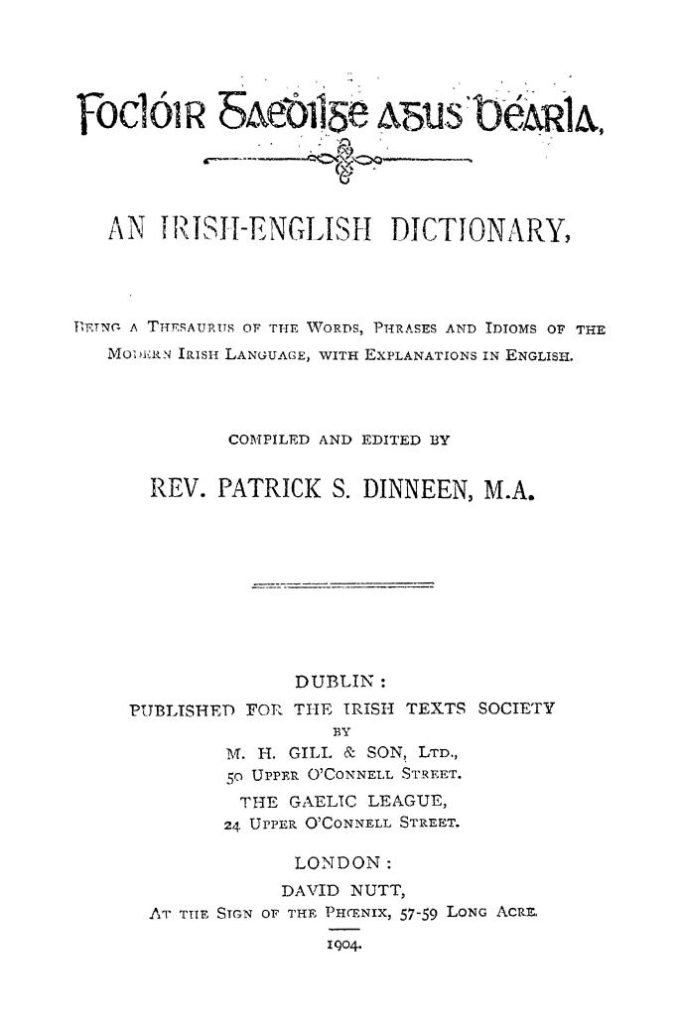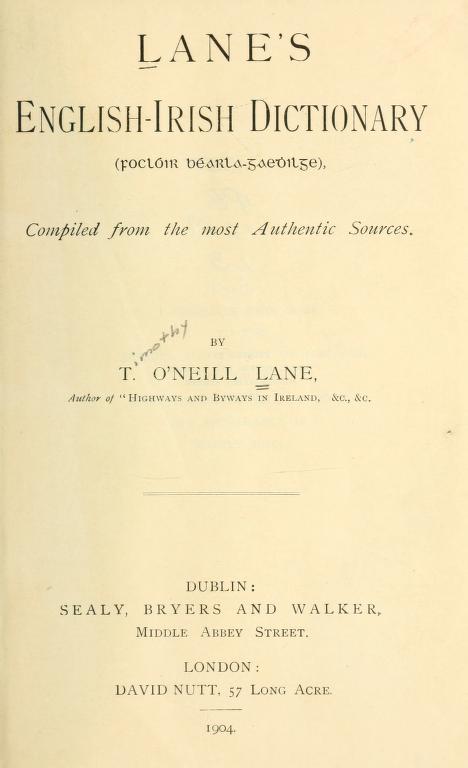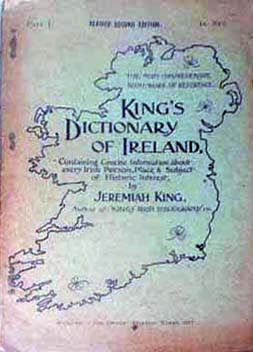As a school principal and a local history researcher, Michael O’Donohoe made good use of the dictionary. Indeed, the collection includes a copy of his own 1977 edition of Foclóir, on the cover page of which is proudly written, Micheál S O Donnchadha.1
Michael’s research papers reveal that he made frequent reference to Rev Patrick Stephen Dinneen’s Irish-English dictionary, Foclóir Gaedhilge agus Béarla, first published by the Irish Texts Society in 1904.
We are put in mind of the scene in Blackadder (‘Ink and Incapability’) when Baldrick lights the fire with Samuel Johnson’s manuscript English dictionary when we read that an enlarged edition of Dinneen’s dictionary was hampered by the destruction of the plates during the Rising of 1916.2
Rev Dinneen, who hailed from the district of Rathmore, reckoned that he expended fourteen years in lexicographical work.3

Another Kerry/Limerick man – both counties appear to claim him – who expended time and money in producing an English-Irish dictionary – Foclóir Béarla-Gaedhilge – at precisely the same time as Dinneen was Timothy O’Neill Lane. His Foclóir – or Lane’s English-Irish Dictionary – was also first published in 1904.4
Lane lived just long enough to see the publication of a revised edition in 1915, the year of his death. He was buried in Brosna, Co Kerry.

Jeremiah King’s rare Dictionary of Ireland (1905) was an ambitious project produced in parts from 1905 to 1924. In 1926, Leabar Temair Eireann, ‘Containing concise information about every Irish Person, Place & Subject of Historic Interest and 4,385 root words’ was noticed in the press, price 6d.
King hailed from Aghadoe, near Killarney.5

A Short Survey of Irish Lexicography
An Irish dictionary was printed in Louvain by Brother Michael O’Clery, the chief of the Four Masters, in 1643. O’Clery was almost seventy years of age.6 It was entitled Foclóir nó Sanasan Nuadh or New Glossary and contained old and obsolete Irish words.
Welshman Edward Lhuyd (1660-1709) incorporated O’Clery’s New Glossary into his Irish-English dictionary which was printed at Oxford in 1707.7
Rev Conor O’Begley, with Aodh Buidhe Mac Cuirtin, published an English-Irish dictionary in Paris in 1732. It was printed in Irish type. Poet Tadhg Ó Neachtain (1670-1752) finished his English-Irish dictionary in 1739.
Before the end of the eighteenth century, Dr John O’Brien, Catholic Bishop of Cloyne, had published in Paris Focaloir Gaoidhilge-Sax-Bhéarha or An Irish-English Dictionary (1768). Bishop O’Brien drew on other works including that of Edward Lhuyd.
In 1817, Edward O’Reilly (1765-1830) published in Dublin his dictionary, An Irish-English Dictionary, ‘containing upwards of twenty thousand words that never appeared in any former Irish lexicon’. It included a note about the fate of the work of Neachtain:
There is in the library of Trinity College a large English-Irish Dictionary compiled by Teig O’Neachtain with an intent to publish it. It appears by a memorandum at the end of the work that he spent six years at it and finished it in the year 1739.8
In the footsteps of Edward O’Reilly was Peter O’Connell from Co Clare. He spent much of his life on his dictionary which he completed in 1819. He could not find a publisher for his work and his manuscript was sold after his death in 1826. Eugene O’Curry believed it to be the most comprehensive Irish-English dictionary in existence.9
Thomas De Vere Coneys (1804-1851) compiled Foclóir Gaoidhilge-Sacs-Béarla or An Irish-English Dictionary. It was published in 1849 and Coneys intended it to fill the want of a dictionary for students of the Irish Bible.
The list is long – goes on, and will continue to do so. The well researched guide to Irish lexicography, Foclóirí & Foclóirithe na Gaeilge (2008) by Liam Mac Amhlaigh provides further reference to the subject.
__________
1 IE MOD/30. 2 In 1920, the Irish Texts Society sought £1,500 by subscription to complete the work of reproducing the dictionary, which was finally published in 1927 and described as the crowning work of Dinneen’s life. 3 A biographical sketch of Father Dinneen is included in The Enchanted Well An Tobar Draoidheachta A Drama in One Act (2018) reproduced by Janet Murphy and translated by Seán Ó Luanaigh. 4 It is not clear if Lane was a Kerry or Limerick man. The census of 1901, in which Lane is listed with the family of his sister Bridget Harnett and her husband William in Abbeyfeale town, indicates that he was born in Co Kerry. The later census (1911) records him living with relations, the O’Kelly family, and suggests he was born in Limerick. Further reference, The West Limerick Man Who Wrote a Dictionary: T O’Neill Lane (2015) by Seaghan Mac an tSionnaigh. 5 King was born at Groin, in the parish of Aghadoe, on 11 February 1868. See biographical article ‘Kerry’s Forgotten Historian – Jeremiah King’ by Edmund Moriarty, O’Donohoe Collection Reference IE MOD/42/42.2. 6 ‘Romance of the Irish Dictionary’ by Daniel Corkery, Irish Independent, 12 April 1920. 7 Archæologia Britannica: an Account of the Languages, Histories, and Customs of Great Britain, from collections and observations in Travels through Wales, Cornwall, Bas-Bretagne, Ireland, and Scotland (1707). ‘Lhuyd circulated in Ireland and Scotland some separate copies of his Irish-English dictionary from his ‘Archæologia Britannica,’ in order to obtain corrections’ (Dictionary of National Biography 1885-1900, Vol 33, ‘Edward Lhuyd by Daniel Lleufer Thomas’). 8 The work was republished by James Duffy in 1864 with a supplement of 6,000 words taken by Dr O’Donovan from the Brehon Laws. 9 Father Jarlath Prendergast from Kilrush, Co Clare, was related to Peter O’Connell. Their relationship is explored in Muckross Abbey A History (2018) by Father Jarlath Prendergast, edited by Janet Murphy.


